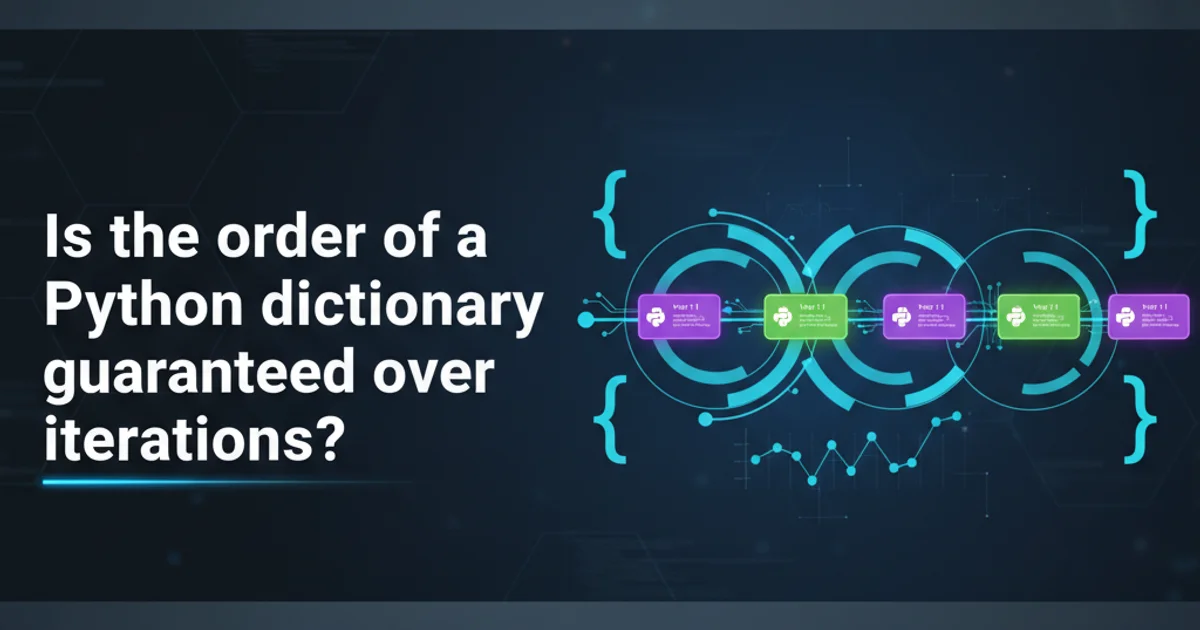Is the order of a Python dictionary guaranteed over iterations?
Categories:
Python Dictionary Order: Guaranteed Iteration and Evolution

Explore the evolution of Python dictionary order, from CPython implementation details to official language specification, and understand its implications for iteration and data processing.
The question of whether Python dictionaries maintain insertion order during iteration has been a recurring topic among developers. Historically, the answer depended on the Python version and even the specific implementation. However, with recent Python versions, the behavior has been standardized and officially guaranteed. This article delves into the history, the current state, and the practical implications of dictionary order in Python.
A Brief History of Dictionary Order
Before Python 3.7, the order of items in a standard dict was not officially guaranteed. While CPython (the reference implementation) did preserve insertion order starting from Python 3.6, this was considered an implementation detail and not part of the language specification. This meant that other Python implementations (like PyPy or Jython) were not obligated to follow suit, and developers were advised not to rely on this behavior for cross-platform compatibility or future-proofing their code.
Python 3.7 and Beyond: Guaranteed Order
With the release of Python 3.7, the preservation of insertion order for dict objects became an official part of the language specification. This means that from Python 3.7 onwards, you can confidently rely on dictionaries maintaining the order in which items were inserted when iterating over them. This change was a significant improvement, simplifying many common programming patterns that previously required collections.OrderedDict.
flowchart TD
A[Python Version < 3.6] --> B{Order Not Guaranteed}
B --> C[Random Order on Iteration]
A --> D[Use collections.OrderedDict]
E[Python Version 3.6 (CPython)] --> F{Order Preserved (Implementation Detail)}
F --> G[Rely with Caution]
H[Python Version >= 3.7] --> I{Order Guaranteed (Language Spec)}
I --> J[Reliable Insertion Order on Iteration]
I --> K[No Need for collections.OrderedDict (Often)]Evolution of Python Dictionary Order Guarantees
# Python 3.7+ example
my_dict = {}
my_dict['apple'] = 1
my_dict['banana'] = 2
my_dict['cherry'] = 3
print("Iterating over keys:")
for key in my_dict:
print(key)
print("\nIterating over items:")
for key, value in my_dict.items():
print(f"{key}: {value}")
# Output will consistently be:
# Iterating over keys:
# apple
# banana
# cherry
#
# Iterating over items:
# apple: 1
# banana: 2
# cherry: 3
Demonstrating guaranteed insertion order in Python 3.7+
Implications for Scientific Computing and Data Processing
In scientific computing, especially with libraries like NumPy and SciPy, dictionaries are frequently used to store metadata, configuration parameters, or results where the order might be implicitly important. For instance, if you're processing data that has a natural sequence (e.g., time-series data, experimental steps), maintaining the order of keys in a dictionary can simplify data alignment and interpretation. The guaranteed order in Python 3.7+ reduces the need for explicit sorting or using OrderedDict in many scenarios, leading to cleaner and more readable code.
When to Still Use collections.OrderedDict
Despite the standard dict now preserving insertion order, collections.OrderedDict still has its place. Its primary advantage now lies in its additional methods, such as move_to_end(), which allow for efficient reordering of elements. If your use case requires frequent reordering of dictionary items, or if you need to maintain compatibility with older Python versions (pre-3.7), OrderedDict remains the appropriate choice.
from collections import OrderedDict
# Example of OrderedDict's move_to_end()
od = OrderedDict()
od['a'] = 1
od['b'] = 2
od['c'] = 3
print(f"Original OrderedDict: {od}")
od.move_to_end('b')
print(f"After moving 'b' to end: {od}")
od.move_to_end('a', last=False)
print(f"After moving 'a' to front: {od}")
# Output:
# Original OrderedDict: OrderedDict([('a', 1), ('b', 2), ('c', 3)])
# After moving 'b' to end: OrderedDict([('a', 1), ('c', 3), ('b', 2)])
# After moving 'a' to front: OrderedDict([('b', 2), ('a', 1), ('c', 3)])
Using OrderedDict for explicit reordering operations.